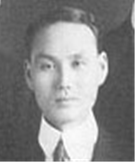Born on October 18, 1885, in Pyongbuk, he lost his father at an early age and lived with his brother, Pastor Hwang Sa-yong, where he was influenced by Christianity from a young age. He received Christian education at Seongshil School and Seongshil University, and while working as a teacher, he was active in the patriotic organization Shinminhoe. When he was pursued by the Japanese police, he disguised himself as a Chinese person and arrived in San Francisco via Shanghai on April 21, 1913.
With the guarantee of Pastor Lee Dae-wi, a representative of the Korean National Association (KNA) who received unofficial approval from the U.S. government, he was able to enter the United States without a passport. Originally, he planned to go to Upland to work for the Korean community, but due to a lack of money, he worked on a tomato farm in Stockton, Northern California, before returning to San Francisco. After enduring various hardships, with the help of his brother, he opened a store that combined a tailor shop and laundry on Mason St. in San Francisco.
He became an evangelist in 1915 and was ordained as a pastor in 1920. He served as an associate pastor at the Shanghai Korean Methodist Church from 1920 to 1928 and as the senior pastor for 14 years from 1928 to 1942. In 1930, the church became the first in the Korean community to acquire its own building at 1123 Powell St. He served as the president of the Korean National Association and the leader of the Heungsadan. During his tenure as a pastor, he provided countless assistance to students and political exiles, helping them find jobs. His decades of service to the church and daily prayers for unification after retirement were a great source of strength for the Korean community in America.
Pastor Hwang Sa-seon, who was member number 9 of the Heungsadan, had two sons and one daughter, Paul, Elizabeth, and Mary, with his first wife, who passed away in 1924. His second wife, whom he married in 1932, died without children. His third wife, Hwang Ok-seok, was a patriotic woman who participated in the March 1st Movement and suffered imprisonment. During this time, they had a daughter named Frances. The Hwang household was always bustling with guests. Pastor Hwang operated a laundry where he made and repaired clothes to support his family, and he continued this work after retirement, helping struggling Koreans.
Paul, the son of Hwang, was born four months after his father arrived in the United States in 1913. He graduated from San Francisco State University and joined the Navy in 1943, serving as a medical staff member for two years. He married Ruth Shin, the daughter of Shin Dae-yun, who was active in the Heungsadan, in 1943. Paul was the son of Hwang Sang-ok, member number 1 of the Heungsadan, and he was also a long-time friend of Choi Bong-yun.

Leave a Reply